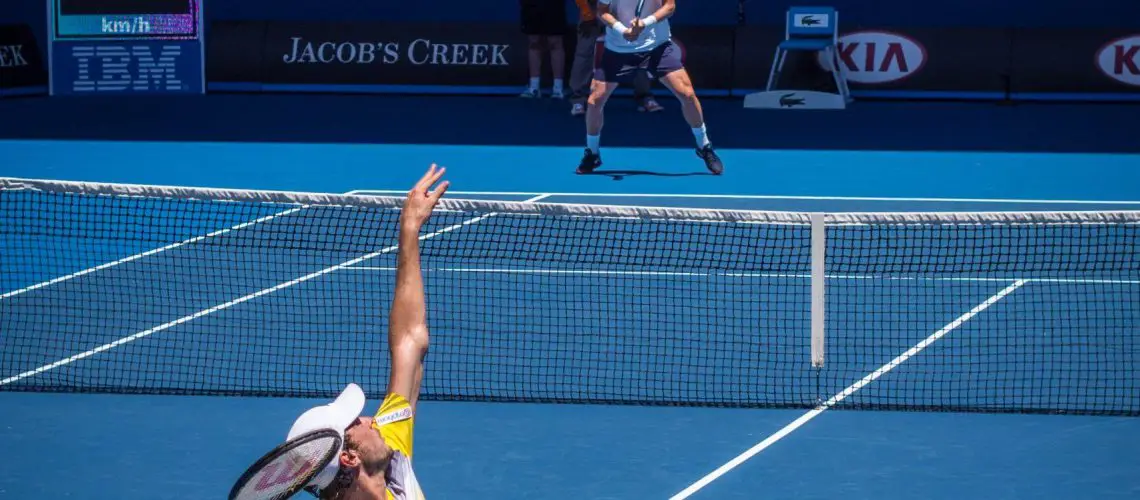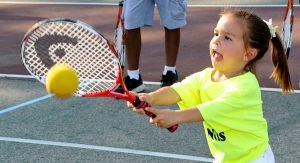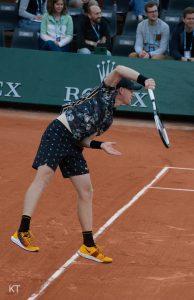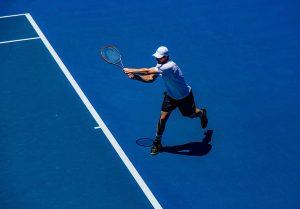We may earn money or products from the companies mentioned in this post.
How To Play Tennis Beginner: The Basics

Introduction to tennis
Tennis, a sport that has been enjoyed for centuries, offers a thrilling and engaging experience for players of all ages and skill levels With its roots dating back to 12th-century France, tennis has evolved into a popular global sport with millions of enthusiasts worldwide
The game of tennis is not only fun but also provides numerous physical and mental benefits From improving cardiovascular fitness to enhancing hand-eye coordination, playing tennis offers a full-body workout while sharpening strategic thinking skills
Equipment Needed for Playing Tennis
1 Rackets
When it comes to selecting the right racket for beginners, there are various options available to suit individual preferences and playing styles From lightweight rackets designed for easy maneuverability to heavier ones providing more power, finding the perfect racket can greatly enhance your performance on the court
Different types of rackets serve different purposes For example, power rackets are ideal for players who rely on strength in their shots, while control rackets offer better precision and accuracy As a beginner, it’s essential to choose a racket that suits your skill level and allows you to develop proper technique without sacrificing comfort
2 Tennis Balls
The type of tennis ball used can significantly affect gameplay and learning progression Beginners should start with low-compression balls that have reduced speed and bounce These balls are easier to control and allow newcomers to develop their strokes effectively
As skills improve, transitioning to regular pressure balls is recommended as they offer more challenge and closer simulation of professional gameplay conditions Additionally, opting for durable balls that can withstand frequent use ensures longevity without compromising playability
3 Appropriate Attire
Wearing the right clothing and footwear is crucial for comfort and performance on the tennis court When it comes to clothing, lightweight and breathable materials such as moisture-wicking fabrics are ideal for keeping cool during intense rallies
For footwear, it’s essential to choose tennis-specific shoes that provide proper support, stability, and traction These shoes are designed with features like reinforced soles and lateral support to prevent injuries while allowing quick movements on the court
Remember, starting your tennis journey with the right equipment and attire can greatly enhance your playing experience and help you develop a solid foundation in the sport So, grab your racket, find a partner or head to a local tennis club, and get ready to enjoy this exciting game!
Understanding the Tennis Court Layout and Scoring System

Tennis Court Dimensions and Markings
When stepping onto a tennis court, it’s essential to understand its dimensions and markings There are distinct differences between a singles court and a doubles court In singles matches, the court is 78 feet long and 27 feet wide, while in doubles matches, the width increases to 36 feet The lines on the court play a crucial role in determining boundaries and areas of play The baseline runs parallel to the net at each end of the court, while service boxes are located on either side of the net
Court Positions and Player Roles in Singles and Doubles Matches
Knowing where to position yourself on the tennis court can significantly impact your gameplay In singles matches, players occupy different positions depending on whether they are serving or receiving The server stands behind their baseline, while their opponent waits across the net In doubles matches, both teams consist of two players each – one serving from behind their baseline diagonally opposite their opponent’s receiver
Scoring System Explained
The scoring system in tennis can sometimes feel confusing for newcomers However, once you grasp its terminology and rules, it becomes second nature The basic unit of score is called a “point” When a player wins a point, they earn 15 points (called “fifteen”). If they win another point consecutively, they gain 30 points (“thirty”), followed by 40 points (“forty”). If both players or teams reach 40 points simultaneously, it results in a “deuce”
In deuce situations, players must win two consecutive points to secure an advantage over their opponent Once someone gains an advantage point after deuce, it is called “ad in” if they are serving or “ad out” if they are receiving If the player with the advantage wins the next point, they win the game However, if their opponent manages to win the next point instead, it returns to deuce
How to Keep Score During a Match
To keep track of the score during a tennis match, you can use a simple system Start by announcing each player’s score before every serve For example, if Player A has 30 points and Player B has 15 points, it would be announced as “thirty-fifteen” As players continue to win points and progress through the game, update the scores accordingly
It’s also common to use abbreviations for scoring announcements Instead of saying “fifteen,” you can use “15,” “30” for “thirty,” and “40” for “forty” Additionally, when announcing deuce situations or advantage points, simply say “deuce,” “ad in,” or “ad out”
Overall, understanding the layout of a tennis court and its markings is crucial for players’ positioning and gameplay strategy Familiarizing yourself with the scoring system ensures that you can follow along with matches and keep track of scores accurately So go ahead, step onto that court with confidence, armed with knowledge about every aspect of this beautiful sport!
Mastering Basic Tennis Strokes and Techniques

The world of tennis is filled with excitement, intensity, and skill To become a master of the game, it’s essential to develop a strong foundation in the basic strokes and techniques Let’s dive into the key elements that will help you elevate your game
Forehand Stroke
The forehand stroke is one of the most fundamental shots in tennis, providing power and control to your game It all starts with selecting the right grip for your forehand – options include Eastern, Semi-Western, and Western grips Each grip offers varying degrees of spin and power, so find what works best for you
Once you’ve got your grip sorted out, mastering footwork becomes crucial Proper footwork allows you to position yourself effectively for each shot, ensuring optimal balance and stability As you execute a forehand shot, focus on stepping into the ball with your front foot while maintaining a solid base
The contact point with the ball is another crucial aspect of a successful forehand stroke Aim to make contact slightly in front of your body to generate power and maintain control over the direction of your shot
Backhand Stroke
The backhand stroke offers versatility in tennis as it can be executed either with one hand or two hands on the racket handle Choosing between a one-handed or two-handed backhand comes down to personal preference and comfort
Just like with the forehand stroke, selecting an appropriate grip for your backhand is essential Experiment with different grips until you find one that allows you to generate power while maintaining control over your shots
To execute a powerful backhand shot, proper footwork is vital Focus on positioning yourself well behind the ball by using quick lateral movements while keeping your body balanced This will enable you to generate maximum power and control when hitting the backhand
Serve Technique
The serve is considered one of the most critical shots in tennis, often setting the tone for each point Perfecting your serve technique involves several key elements
Start by ensuring proper placement of your feet during the serve The feet should be shoulder-width apart, allowing for a stable base and weight transfer throughout the motion
Toss height and timing play a significant role in a successful serve Experiment with different toss heights to find what works best for your desired type of serve – whether it’s a flat serve, slice serve, or kick serve Practice getting the timing right to maximize power and accuracy
Volley Technique
Volleying requires quick reflexes and precise shot placement at the net Mastering this technique involves several key components
Firstly, ensure you have a proper grip on the racket that allows for control and maneuverability at close range Experiment with different grips until you find one that feels comfortable and natural for volleying
The split-step technique is essential when preparing to volley As your opponent hits their shot, perform a small jump or hop to regain balance and react quickly to incoming balls Combine this with efficient footwork to position yourself optimally at the net
Finally, positioning yourself correctly at the net is crucial for successful volleys Anticipate where your opponent’s shot will land and adjust accordingly, maintaining an aggressive but controlled stance ready to pounce on any opportunities that arise
Tennis Strategy and Practice Tips for Beginners

When it comes to tennis, having a solid strategy can make all the difference in your game As a beginner, focusing on basic tactics will help you lay a strong foundation for improvement Firstly, aim for consistency in hitting the ball This means practicing your strokes until they become second nature, allowing you to maintain control during rallies
Another key aspect of tennis strategy is shot placement By strategically placing your shots across the court or down the line, you can force your opponent into difficult positions and gain an advantage Experiment with different angles and trajectories to keep your opponent guessing
In addition to shot placement, it’s important to develop a repertoire of various shot types Lobs, slices, and drop shots are just a few examples of shots that can add variety and surprise to your game Mastering these different shot types will give you more options during matches and make you a more well-rounded player
Mental Aspects of Tennis
Tennis is not just about physical skills; it also requires mental toughness Developing mental resilience on the court is crucial for maintaining focus and composure during intense moments One way to build mental toughness is through consistent practice under pressure situations
Handling pressure situations during a match can be challenging for beginners It’s important to stay calm and focused when facing tough opponents or when trailing behind in a game Mental exercises such as visualization techniques or deep breathing exercises can help you stay centered during high-pressure moments
Practice Exercises and Drills
To improve your overall game, incorporating specific practice exercises and drills into your training routine is essential Wall practice is an effective method for stroke improvement as it allows you to focus solely on technique without needing a partner
Additionally, creating specific drills for your forehand, backhand, serve, and volley will help you refine these fundamental tennis skills By isolating each stroke and practicing them repetitively, you can develop muscle memory and improve your overall technique
Cardio tennis workouts are another excellent way to increase your endurance on the court These high-energy workouts combine tennis drills with cardiovascular exercises, keeping you physically fit while simulating game-like conditions
Finding Practice Partners and Joining Local Clubs or Leagues
To enhance your practice sessions and gain valuable experience playing against different opponents, finding practice partners is crucial Look for local clubs or leagues where you can connect with fellow tennis enthusiasts at a similar skill level Playing with others will not only improve your game but also provide a sense of camaraderie and motivation
In conclusion, by focusing on basic tactics such as consistency in hitting the ball, shot placement, and using various shot types, beginners can lay a strong foundation for their tennis game Additionally, developing mental toughness and incorporating practice exercises and drills into training routines will lead to significant improvement Finally, finding practice partners and joining local clubs or leagues will offer opportunities for growth through competitive play
Useful Links

Getting Started Playing Tennis For Adults
Tennis for beginners: how to start playing tennis
5 Tennis Tips for Beginners | How To Improve Your Skills
For a tennis beginner, how many hours of training are …
5 Things to Know for Your Beginner Tennis Lessons
Tennis rules: Know how to play
Tennis for beginners | How to get started
Beginner’s Guide to Tennis
Top 20 Actionable Tennis Tips For Beginners| (That Make …
Beginner Tennis Lessons | Learn Tennis Cheap
Tennis for Beginners: The Fastest Way to Learn Tennis
Everything you need to start playing tennis – Reviewed
How To Play Tennis – The Beginner Guide
Tennis for Beginners: The Ultimate Guide
Beginner Adult Tennis Classes at JTCC in College Park, MD
What a 10-Year-Old Tennis Beginner Learned in 2 Hours
Tennis Beginner vs Intermediate (Main Differences)






